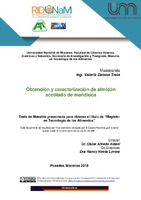Obtención y caracterización de almidón acetilado de mandioca
Abstract
La industria del almidón y sus derivados representa una regular fuente de ingresos en la explotación agraria de la provincia de Misiones, siendo esta provincia la que presenta la mayor producción de mandioca de la Argentina, por lo que es una
materia prima de gran interés regional. El almidón es ampliamente utilizado en la
industria alimentaria como agente espesante y gelificante, sin embargo su forma nativa presenta baja resistencia al corte, poca resistencia térmica y alta tendencia a la retrogradación, lo cual limita su uso en algunas aplicaciones. Debido a esto, se realizan modificaciones por medio de métodos físicos y químicos, que tienen como propósito la alteración de las propiedades del almidón nativo para mejorar sus características funcionales, y de esta manera, poder adaptarlo a aplicaciones específicas. La acetilación es uno de los métodos de modificación química del almidón que se utiliza comúnmente para aumentar la resistencia al agua, ya que los grupos hidroxilo (hidrófilo) son sustituidos con grupos acetilo (hidrofóbicos) que reducen la formación de puentes de hidrógeno entre las cadenas del polímero y las moléculas de agua, disminuyendo su solubilidad. Asimismo, esta modificación química del almidón, mejora su plasticidad y su performance cuando es aplicado en los procesos productivos respecto al almidón nativo. En el presente trabajo de tesis se pretende sintetizar almidones modificados químicamente por medio de dos métodos diferentes de acetilación, con la finalidad de obtener una variedad de almidones modificados de mandioca que presenten un amplio rango de grados de sustitución y determinar las características morfológicas, físicas y funcionales de los mismos. The starch industry and its derivatives represent a regular source of income in
the agricultural production of the province of Misiones, having this state the highest
production of cassava in Argentina, being a raw material of great regional interest.
Starch is widely used in the food industry as a thickener and gelling agent, however its native form has properties such as high tendency to retrograde, low mechanical and poor thermal resistance, which limits its use in some applications. Due to this,
modifications are made by means of physical and chemical methods, which have as
purpose the alteration of the properties of the native starch to improve its functional
characteristics, and in this way, to be able to adapt it to specific applications.
Acetylation is one of the methods of chemical modification of starch that is commonly
used to increase water resistance, since hydroxyl groups (hydrophilic) are substituted
with acetyl groups (hydrophobic) that prevent the formation of hydrogen bonds between polymer chain and water molecules, decreasing their solubility. Also, this chemical modification of starch improves its plasticity and its performance with respect to the native starch, when it is applied in productive processes. In this thesis the aim is to synthesize chemically modified starches using two different acetylation methods, in order to obtain a variety of modified cassava starches, with a wide range of substitution degrees and to determine the morphological, physical and functional characteritics of them.
Collections
- Maestría [55]
The following license files are associated with this item:



